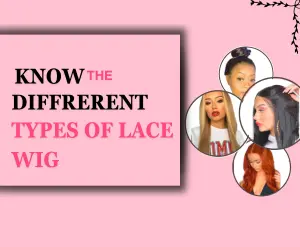
different types of lace wigs: Know Which one is your type
Things you should must know before buying any Lace wig, Know the different types of lace wigs first, and find your best one type
Wig plays a major role to create our look and is the easiest way to upgrade the hairstyle without doing many changes to our natural hair.
Everyone wants to wear a wig that looks natural and gives the feel that hair grew from the scalp. But the knots on the wig makes it less natural and fake. To address this issue, many wig manufacturers turn to bleach the knots.
And this is the main cause; we bleach the wig knots. Bleaching the knots significantly improve the wig’s appearance by lighting the dark-colored knots present on the lace to match the color of the wig’s hair.
But bleaching the knot is not an easy procedure, especially for those who are new to this field. This is because bleaching functions too fast as well as alters the wig permanently. There is a lot of space for mistakes, this can only to manage by proper guidance. This article provides step-by-step guidance on how to bleach the wig’s knot with helpful tips and precautions to ensure the best possible outcomes. We will also have a look at the mistakes such as over-bleaching and not protecting the hair of the wig during the whole method.
Before going to discuss the actual procedure, you should need to know what is a synthetic wig.
Synthetic wig is made through man-made fibers that is also known as synthetic fiber. The fiber is made from synthetic materials such as nylon, polyester, and acrylic. The wigs made from this fiber look natural but are not as durable as wigs made from natural hair. These wigs also do not look natural because they are cheap than human hair wigs. So, you need to do some maintenance so that it looks natural when you wear it, bleaching the knot is one of the techniques to give your synthetic wig a natural appearance.
People bleach synthetic wig because of many reasons but one the most prominent causes of bleaching synthetic wig are that the knots do not look natural, bleaching can reduce the visibility of these knots because knots become lighter and this procedure helps to make the wig look more natural like human real hair.
It’s the most typical question; Is it possible to bleach the synthetic wig knots? The answer is simply Yes. Bleaching the wig knots is the process that makes the hairline of the wig appears to be more natural by lightening the shade of the visible knots of wigs.
But it requires some reservations to execute it safely and achieves the best result. It’s not always recommended to bleach the synthetic wig without any guidance because bleaching can damage the wig fibers, leading to vulnerable to breakage. This article will further provide you the guidance that how to bleach the wig knots.
Wig knots are tiny knots that appear at the point where each hair strand is tied to the lace cap of the wig. The knots are hand-made by the technique called ventilating. The technique involves the small hock which is used to pull out an individual strand through the lace cap. This process requires time and skills to ensure that the knots are evenly spaced or not to make the hair look natural. These knots are important because it helps to keep the hair attached to the lace and prevent the hair from shedding or falling out. However, there are two types of knots; Single knot of a wig and double knot. Let’s discuss both the knot one by one;
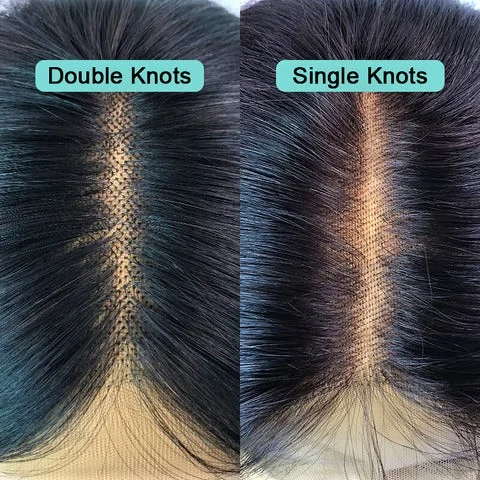
Single knots refer to tying a single strand of hair onto the cap of a wig, so they are smaller in size as compared to double knots. They are less noticeable due to their smaller size, giving the wig hairline a very natural appearance. One of the best things about a single knot is that they are easier and quicker to bleach. But the downside with the single knots includes that they can shed very easily.
Double knots refer to more than one hair strand that conjoins the wig cap. That’s why double knots are more secure but can create a bulkier look at the hairline, making it less natural. These knots are easily noticeable and require more struggle to bleach. These knots are not shed easily and are firmer as compared to single knots. This is the main reason, wig makers focus to create single knots around the area of the hairline, however, the double knots penetrate to the rest of the lace. In this way, a secure wig is made that gives the natural look.
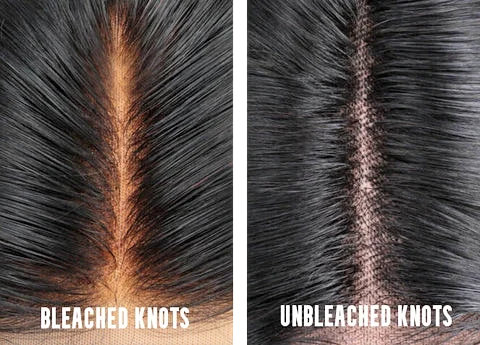
Before bleaching the knot there are some factors that you need to know about bleached knot and unbleached knots.
The wig with bleached knots will appear to be more natural because it matches your skin shade when you set the wig on. It feels like the hair is coming from the scalp. This is the most obvious advantage of bleaching the wig knots, however, it has the disadvantage that it makes the wig fragile and prone to shed easily.
Unbleached knots of the wigs don’t shed easily and are stronger but they contain a black dot at the base of the cap that looks artificial when you wear it.
Bleaching knot is the technique of making the knots of the wig less visible with the help of bleach. The bleach helps to lighten the black dots that appear at the base of the cap by blending the color of the lace cap and skin. Bleaching the wig knots might sound difficult to you, but it will become easier than you imagine, once you get your hand on it. So here is a step-by-step guide on how to bleach the knots.
For bleaching the knot, you should contain all the essential tools. Because bleaching is a process that requires special care, so you should have the following tools;
Once you have all the tools you can start the process of bleaching the knots. The bleaching of the wig knots can be done by following steps.:
First of all, ready the wig before starting the bleaching process. Attach the wig to the mannequin’s head. In case, if you don’t have the mannequin’s head, pin it tightly on a gentle surface similar to the foam head. Ensure to clip away the baby hairs of the wig before you bleach the knots. Otherwise, the baby hairs might also be bleached along with wig knots.
Now, spray some water on the roots of the wig hair to protect the lace if the bleach leaks from the lace.
Protect your hands by putting on gloves before you start preparing the mixture of bleach. Then, make a mixture of bleach and developer. Read the instructions present in the packaging of the product. Generally, the ratio must be 1:1 (1 ounce of each developer and bleach).
Stir the mixture well to make the mixture thick in consistency. Note down, the mixture should not be too runny otherwise it will leak through the lace and damage the roots
Apply the bleach mixture on the front hairline. You should gently brush the bleach mixture on the knots otherwise it will leak through the lace to damage the hair.
After applying the mixture, cover the knots with the help of aluminum foil for 30 minutes. Some wigs are bleached in 15 minutes. So, check the wig after interval of several minute to prevent over-bleaching of knots
Make sure to rinse the bleach on time, after you get your desired color. Then, apply purple shampoo to eliminate any chemical particles. After shampooing, apply the hair conditioner for 3 minutes to soft the hair strands and lock the moisture back to the hair strands. It will help the wig hair to dry out.
Quick tip: Avoid using shampoo on the wig for more than twenty minutes otherwise, it may damage the hair and make it rough and dull. You can follow some tips for dry and frizzy wig
Gently, squeeze the strands of hair to remove the excess water it. You can also use the towel to absorb the water and then hang the wig to facilitate the process of drying but do not use the blow dryer to dry the wig faster because it can spoil the wig. Besides, don’t hang the wig in the area where the wig comes in the direct exposure to UV rays, because it may also damage the wig.
Quick Tip: Avoid using a blow dryer soon after washing the wig to dry it faster, otherwise, it will damage the hair strands.
Errors are part of life. You are more likely to make any error like over-bleaching the knots or bleach leaked out to the roots of the wig hair and damages it. You can use the following instruction to fix your wig in case of excessively bleaching the knots.
Gently, brush the mascara to the affected areas of overly bleached knots until the mascara is evenly applied to the area and gives the natural look. Let the mascara dry naturally.
It sounds a bit frustrating that to permanently fix the wig you need to dye your wig once you finished bleaching it. It is an economical way to fix your wig than to waste your money on buying a new wig. Dye the hair similarly you bleach the knots.
Prepare the dye mixture in the bowl and follow the instructions as mentioned in the package. Then, apply to the targeted areas that are affected and make sure to avoid dyeing the wig-bleached knots. Leave the mixture on the wig for 30 minutes and then properly rinse the hair with normal water and wash it later with shampoo. Apply conditioner for 3 minutes and let it dry naturally.
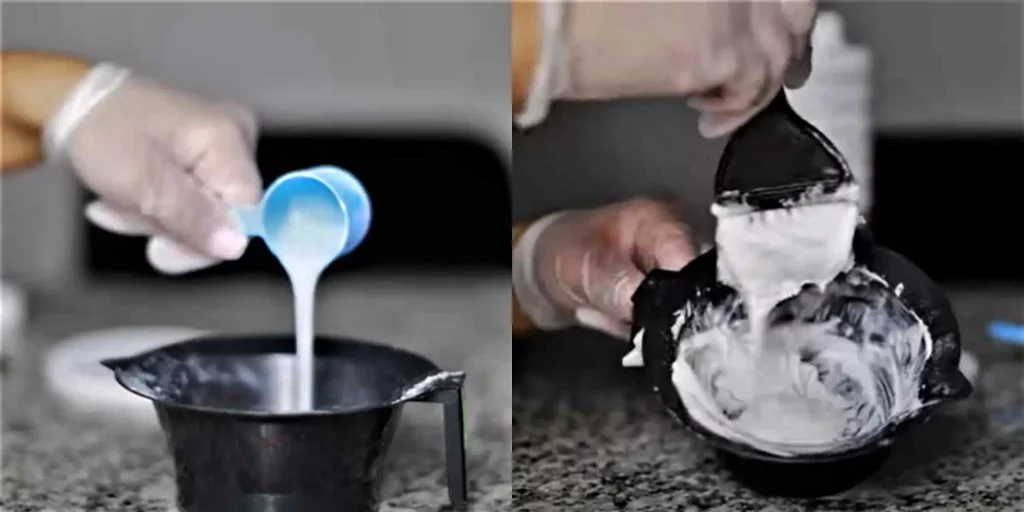
Bleaching knots is considered the most usual practice. You should know the advantages of it;
Knots don't look natural when you wear the wig, so it's important to bleach the knots to make them less apparent. It gives you a more natural look.
Bleaching the knots makes the knot lighter in shade and creates a look that looks natural when you wear the wig.
You get a variety of options to style your hair when you bleached the knots because bleached knots provide a surface for styling.
Bleached knots don't irritate the scalp, so it's comfortable to wear a wig with bleached knots for a long duration.
Because bleached knots look real so they increased your confidence when you wear them.
Bleaching the knots is the process of using the chemical to lighten the shade of knots that are present in the wig, it’s an important step as it makes the knots less visible for the one to judge. But it has some disadvantages along with advantages. Disadvantages are linked to the common effects that are caused by using any chemical. Here are some disadvantages of bleached knots that you should know.
it’s the most obvious disadvantage. Because bleach is a chemical that causes hair damage and makes it more prone to breaking and shedding. Bleaching the knot without following proper instructions can do more damage to the wig hair.
Bleaching knots cause the wig to shed the hair strands or damage the hair. In this way, the lifespan of the wig may be reduced.
Bleaching the knot is an undone process that required proper focus on each step but still, it damages the hair and reduces the life span of the wig. If you want to reduce the visibility of the wig knots without damaging the wig then there are alternative options than bleaching the knots.
Apply the concealer that matches the shade of your scalp, aid to makes the knots less noticeable without damage.
Apply the tinted spray can help to make the knots darker in color and give natural look.
These kinds of hairpieces come with bleached knots. So, you don't need to bleach the knots.
It is not necessary to bleach the knot, but it can help make the hairpiece look more natural by reducing the visibility of the knots.
Yes, bleaching the knot can damage the hairpiece if not done correctly. Over-bleaching can cause the hair to break or fall out, and the bleach can also weaken the lace or silk base of the hairpiece.
It is not recommended to bleach the knot too frequently, as this can damage the hairpiece. It is typically done before the first use, and then touch-ups can be done as needed.
The lace melting spray is not typically used as an alternative to bleaching the knot. Melting spray is a type of adhesive used to secure the hairpiece to the scalp. It can be used to melt the lace of the hairpiece into the scalp, making it look more natural. However, it does not provide a solution for hiding the knots

Things you should must know before buying any Lace wig, Know the different types of lace wigs first, and find your best one type
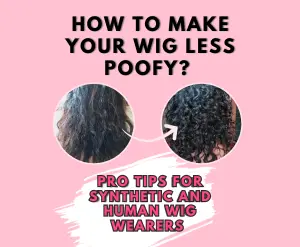
know the pro tips and expert guide to make your human and synthetic hair wig less poofy, Pro tips and things to avoid

Finding an affordable glueless lace front wig can be challenging for beginners. We review and ranked you 16 best Glueless Lace Front Wigs

Secrets to Accelerate Hair Growth Under Your Wig with 20 Expert Tips! Discover the Ultimate Guide for Longer, Healthier Locks

We reviewed and ranked the 14 best HD Lace wigs, with pros and cons, by looking into budget and quality considerations,

We review and choose top-quality 360 lace wigs for you in 2023. Make informed choices for a natural and stylish look.